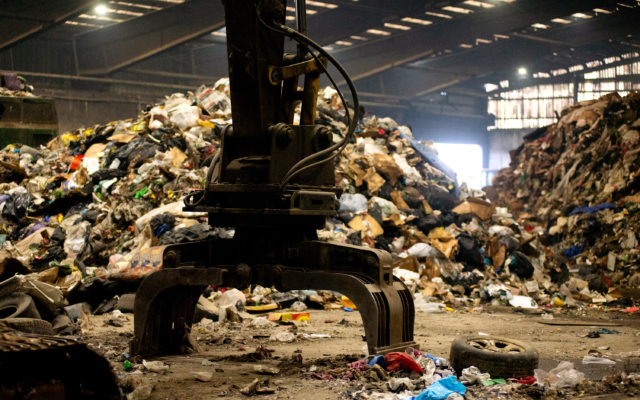
With Hampden waste plant’s reopening in the works, Orrington rival sees chance to collaborate
By David Marino Jr., Bangor Daily News Staff
As a shuttered waste processing plant in Hampden looks to reopen under new ownership later this year, the Orrington incinerator that’s been handling most of the Bangor area’s waste in the interim sees a chance for collaboration with the waste plant across the river rather than continued rivalry.
“I think two facilities can survive,” said Henry Lang, plant manager at Orrington’s Penobscot Energy Recovery Co., or PERC, which has generated electricity by burning trash since the 1980s. “If the two facilities work together, they actually come out ahead.”
PERC has struggled to stay profitable and find new sources of waste since more than 100 towns and cities stopped sending their household trash there in 2018 in favor of the Coastal Resources of Maine plant in Hampden that was supposed to open that year. The Orrington plant has since upgraded its equipment to reduce processing costs and incinerate a larger portion of the waste it takes in. But a few other ventures — including one to prepare Maine wood chips for export to Europe, and another to import shredded plastic waste from Northern Ireland — haven’t panned out.
PERC currently takes in 11,000 to 12,000 tons of waste a month, which works out to about 44 percent of the amount it processed in 2017. It has also seen substantially less revenue from the electricity it generates: In 2018, before a special agreement that gave it above-market rates for its electricity expired, PERC made $173 per megawatt hour, compared with about $35 today.
On some level, collaboration with the plant located just across the Penobscot River has already begun. Most of the waste from towns and cities that had been sending trash to Coastal Resources of Maine has been heading to PERC instead since Coastal Resources closed last spring after just six months of full operations, unable to pay its bills.
PERC scaled up its operations, adding new staff, to take in the new waste after it had previously downsized to “live within our means,” Lang said. Though Lang initially believed the arrangement would be a double-edged sword, he now describes it as a “net positive.”
It’s provided municipal waste that PERC is accustomed to processing, instead of commercial waste, which Lang said can contain materials such as metals that are difficult to break down.
Long-term, Lang said, there is more than enough municipal waste in the Bangor area and the rest of Maine for two sizable waste facilities in the region.
Once the Coastal Resources plant reopens, the communities that have been sending their trash to PERC will once again send their waste to Hampden, though Lang expects that some of those communities will continue to send some waste to PERC during Coastal Resources’ startup period.
“There’s going to be, I assume, a startup phase,” Lang said. “And if we can help in that timeframe by taking some of that waste, we certainly will, as long as the price is right.”
One of PERC’s attempts to generate new revenue was a plan the company floated in 2019 to build a $15 million facility on its property to prepare Maine wood chips for export to Europe, where the chips would be used as biofuel. The facility would have used electricity and steam from the trash incinerator to kill pathogens before shipping the wood chips abroad.
However, that venture didn’t work because the economics “didn’t prove out,” Lang said.
Another deal, with Northern Ireland-based company Re-Gen, turned south after two bales of shredded plastic were dropped into Penobscot Bay in December while an 8,000-bale shipment was unloaded at the Sprague Energy Terminal on Mack Point. One of the bales couldn’t be recovered, and the trash soon began washing up on the shores of nearby Sears Island.
PERC pursued the deal with Re-Gen after twice running out of fuel for its boilers last winter, peak season for electricity demand. It was looking for a fuel that was “storable and stable” and that it could keep on hand if it ran out of waste to burn, Lang said. The company found that in the material offered by Re-Gen, which is 85 percent plastic.
While some questions were raised in British press about why Re-Gen was sending the material to North America in the first place, Lang said PERC viewed it as an environmentally conscientious effort: the material would have otherwise been diverted to a landfill. The first 20 shipments of the material came in January and February 2020, he said.
The December spill was a “one-off, extremely unfortunate” event that the company had worked to mitigate, Re-Gen spokesperson Sinead Little said in a statement. In its seven years of shipping waste around the world, the spill in Penobscot Bay was the first of its kind, according to the company.
“This was an unacceptable occurrence and entirely preventable,” Little said.
PERC staff were “horrified” to see pictures of the trash wash up on Sears Island, Lang said. While PERC continues to hold material it received from Re-Gen, it has not ordered a new shipment since the spill.
“If anybody ever wanted to bring that again, we don’t know what could be done to guarantee that they wouldn’t spill something,” Lang said. “And that’s a real troubling point for us.”
PERC has also experimented with other fuel sources, including waste collected by the Maine Department of Environmental Protection from cleanup sites and baled recyclables that had no other outlet due to a depressed, worldwide market for recyclables.
Power prices have been “abysmal,” Lang said, noting that consumers might appreciate low electricity prices, but they make it difficult to keep PERC afloat.
“This is not a cheap operation,” Lang said. “The waste-to-energy plant is not the cheapest way to get rid of waste. The cheapest way, for the short-term, is to put it in a landfill.”